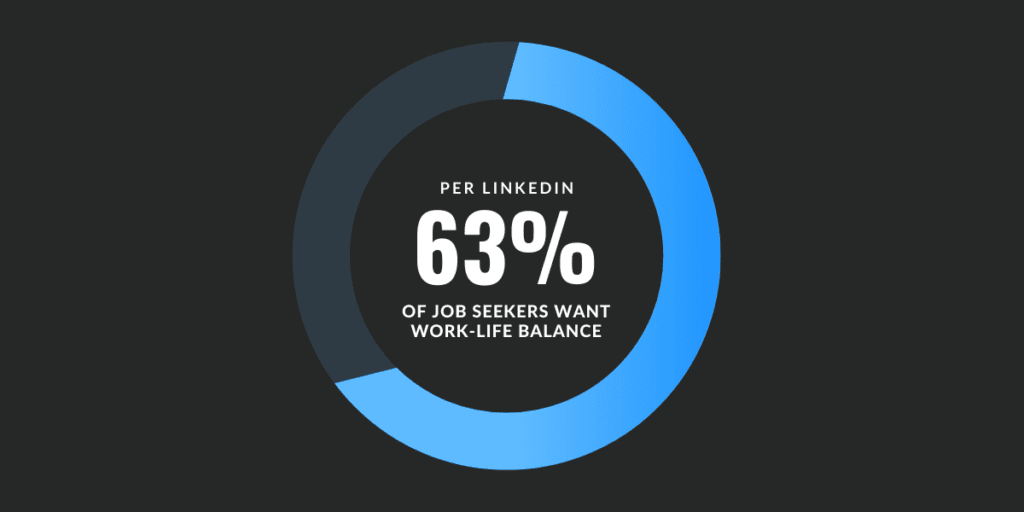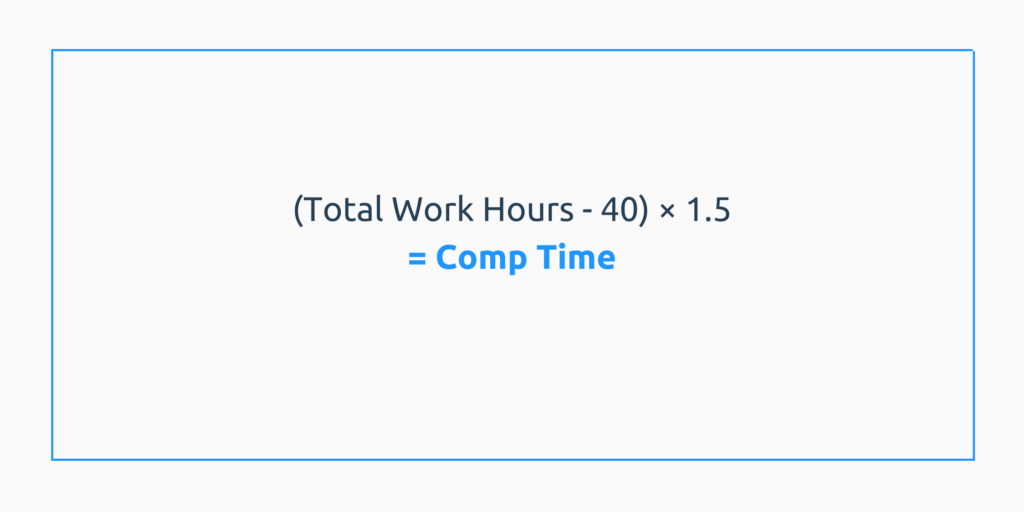Flexible work options offer employees and employers ways to better balance work and life priorities. While there are numerous flexible working arrangements, the debate usually boils down to flex time vs. comp time.
The two terms are very different as each method operates under its own distinct rules and regulations. Each method also differs in how it benefits both employees and employers:
- Employees. Understanding the difference between flex time and compensatory time greatly helps employees manage work hours effectively.
- Employers. Understanding these concepts ensures compliance with labor laws like the Fair Labor Standards Act (FLSA) for employers, particularly in the private sector. Misunderstandings can lead to issues with overtime pay, pay periods, and fair treatment for hourly employees working extra hours.
In this post, we’ll discuss the key differences between flex time and comp time, their benefits, and how they fit into workplace policies.
Boost your team’s efficiency with Hubstaff's productivity tools
What is flex time?
Flex time allows employees to set their own schedules based on parameters set by their employer. Instead of working a traditional 9-to-5, it focuses on completing tasks rather than adhering to rigid week-to-week schedules.
This is common for salaried employees and some hourly workers, though it doesn’t usually include extra monetary compensation like overtime. Flexibility works as long as all tasks are completed within the agreed-upon time frame.
Examples of flex time schedules
Flex time can look different depending on the company and role. Here are a few examples:
- Early mornings. Starting work at 7:00 AM and ending at 3:00 PM instead of the usual 9-to-5.
- Four-day workweek. Working four 10-hour days instead of five 8-hour days.
- Split hours. Work mornings and evenings but leave afternoons open. This method is great for parents with kids to pick up from school.
Schedules like these allow employees to manage personal priorities while meeting work demands. For employers, it’s a simple way to show you trust employees, which can help improve their satisfaction and work-life balance.

Benefits of flex time for employees and employers
Flex time offers advantages that benefit both sides of the workplace:
| Employees | Employers |
| Improved work-life balance. Employees can manage work and personal priorities more easily. More freedom. Increased flexibility creates more time for personal obligations like childcare, meal planning, family emergencies, travel, etc. Reduced stress. Less burnout from rigid schedules and better work-life balance. Increased employee satisfaction. Increased satisfaction from feeling valued and trusted. | Increased productivity. Flexible schedules allow each employee to align their schedules with their peak hours. Lower absenteeism. Unscheduled absences are often a result of scheduling conflicts. Allowing employees to build their work schedule around important appointments alleviates that. Better retention. Employees who feel trusted are more likely to stay with the company – which saves employers significantly. |
What is comp time?
Comp time, short for compensatory time, allows employees to take paid time off instead of receiving overtime compensation for working extra hours. While it’s more common in the public sector, some private employers offer comp time as an alternate way to reward overtime work.
It’s important to note that its use is tightly regulated under the Fair Labor Standards Act (FLSA) and depends on whether employees are classified as exempt or non-exempt.
Comp time vs. overtime: Key differences
| Comp time | Overtime |
| Employees receive time off for extra hours worked. Common for public sector roles, rarely allowed in the private sector. Tied to FLSA exemption status; not available to most non-exempt employees. Time off must be taken within a set period or may be forfeited. Viewed as a benefit or scheduling perk rather than extra income. | Workers are paid for extra hours, usually at a better rate than their normal hourly pay. Standard practice for private employers to meet FLSA rules. Required for non-exempt employees after 40 hours in a week. Compensation is immediate, typically in the next pay period. Provides immediate overtime compensation for extra work. |
Comp time guidelines for salaried and hourly employees
By now, you’re probably a little overwhelmed by some of the legal jargon and compliance standards associated with comp time. If you’re new to the concept of comp time (or just need a refresher), here are a few terms you’ll need to know:
- Non-exempt employees. Generally not eligible for comp time under FLSA, as they are legally entitled to overtime pay.
- Exempt employees. May be offered comp time as they’re excluded from overtime hours rules.
- Accrued limits. Employers must cap accumulated comp time to avoid excessive liabilities.
- Time tracking. Teams must document hours to verify eligibility and prevent disputes. You can track time manually or use time tracking software to automate the process.
- State laws. Comp time may be prohibited or restricted depending on the state. We recommend reviewing guidelines from the U.S. Department of Labor (DOL) or consulting a qualified labor attorney to ensure compliance with federal and state laws.
Examples of comp time policies in practice
Now that you’ve familiarized yourself with our comp time glossary, let’s take a look at some examples of situations where comp time policies do and don’t apply:
- Public sector. A firefighter works 50 hours in one week, accumulating 10 hours of comp time to take off in the future.
- Exempt employees. A manager works an extra 10 hours during a busy project and arranges to take a day off later.
- Non-exempt employees. A warehouse worker earns overtime but opts for comp time (if local laws allow) to balance personal obligations.
- Private employers. An IT company allows salaried employees to bank comp time for extra hours on project deadlines.
Flex time vs. comp time: Key differences
While both flex time and comp time offer alternatives to traditional work arrangements, they differ significantly in structure, purpose, and regulation.
Flexibility in scheduling
Flex time is about adjusting when work is done. Employees can structure their hours around personal needs — as long as tasks are completed.
It’s particularly popular in roles where productivity matters more than presence, like salaried positions or creative roles.
Comp time, on the other hand, is tied to extra work. Employees earn compensatory time off instead of being paid for overtime hours worked. Unlike flex time (which is proactive and employee-driven), comp time is reactive — rewarding workers for additional effort.
In short, flex time prioritizes when work happens, while comp time addresses extra work already completed.
Legal considerations and regulations
FLSA regulations set strict boundaries for compensatory time.
For non-exempt employees, comp time is rarely an option in the private sector, as they are entitled to overtime pay under federal law. However, public employers can legally provide comp time for:
- Government employees. Comp time is allowed for federal, state, and local government employers, as they are exempt from the private sector’s stricter overtime pay requirements.
- Voluntary agreements. Public sector employees can agree to accept comp time instead of overtime pay as long as a written agreement establishes this in advance.
- Accrual limits. Non-exempt employees in the public sector can accrue up to 240 hours of compensatory time (or 480 hours for employees in specific emergency response roles like firefighters or police). If these limits are exceeded, overtime pay must be provided.
- Timely use of comp time. The employee must be allowed to use their accrued comp time within a reasonable period, as long as it doesn’t “unduly disrupt” agency operations.
Comp time policies are more flexible for exempt employees, as they are not entitled to overtime pay under the FLSA. However, even for exempt roles, state laws may impose additional restrictions.
Whether employers can legally provide comp time depends on several factors, including the worker’s classification, hours worked, and state guidelines.
Missteps in compliance can lead to costly fines, so businesses must thoroughly understand the law (ideally with the help of legal experts) before implementing a comp time policy.
Comp time calculator: How to calculate comp time
Calculating employees’ compensatory time is straightforward but must align with legal requirements. Here’s how it typically works:
- Determine the overtime hours worked. Total up weekly overtime hours. For example, if an employee works 45 hours in a week, they’ve accrued five overtime hours.
- Apply the FLSA standard. Each hour of overtime should count as 1.5 hours of compensatory time. In this case, five overtime hours convert to 7.5 hours of comp time.
- Track and document accrued comp time. Track time manually or keep more accurate records with an automatic time tracking tool like Hubstaff. This way, you can ensure compliance and prevent disputes over payment or time off.
Employers using comp time calculators must remember to keep employee classifications and state and federal laws in mind.

Flex time and comp time policies
Crafting effective policies for flex time and comp time requires a balance between legal compliance and addressing employee needs.
A well-designed policy is fair to employees, avoids legal pitfalls, and prioritizes workplace satisfaction. Let’s take a look at how you can create a policy for your company.
Creating a flex-time policy for your company
Creating a flex-time policy is about your employees above all else. Survey your workforce to understand their needs and expectations for flexible work hours.
- Remember: Anytime you’re creating a policy, employee input is the most valuable source of information.
It’s also important to establish guidelines about core hours, expected availability, and approval processes for flex schedules.
Flex time may affect time tracking, payment, and leave accrual, so it’s crucial that you get it right. That’s why we strongly advise you to consult employment lawyers to ensure your policy aligns with local, state, and federal laws.
Setting up compensatory time off guidelines
If you’re going to implement a comp time policy, you’ll have to adhere to strict FLSA regulations.
- Eligibility. Clearly define which roles are eligible to receive compensatory time.
- Documentation. Keep detailed records of accrued comp time to avoid disputes over unpaid hours or time-off eligibility.
- Limits. Set caps for accumulated comp time and require employees to use their accrued time within a reasonable period. Articulate what tools you’ll use to manage these limits.
- Legal review. Work with legal experts to confirm your policy complies with state and federal laws — especially if operating in the private sector.
A comp time policy can be a valuable tool, but only if it’s airtight.
Clear rules, proper documentation, and legal oversight aren’t optional — they’re part of the foundation of a compliant business. Failure to adhere to compliance standards could lead to costly disputes.
Best practices for managing flex time and comp time in the workplace
- Communicate policies clearly. Ensure employees understand how flex time and comp time work, including eligibility, tracking, and usage. Transparent policies prevent confusion and disputes.
- Use tracking tools. Implement time tracking software or systems to monitor work hours and manage accrued comp time accurately. Make sure that each and every employee understands why and how you’re tracking their time.
- Prioritize fairness. Apply policies consistently across positions and teams. This will help prevent perceptions of favoritism, a commonly cited cause of reduced employee loyalty and increased turnover.
- Regularly review policies. Periodically evaluate and update policies to stay on top of changing labor laws and business needs.
- Monitor burnout risks. For both flex and comp time, watch for signs of employee overwork or — as difficult as it might be — misuse.
- Practice open, constant feedback. Establish open communication lines where employees can share concerns or suggestions about flex and comp time policies. Listening to their input helps refine processes and boost trust.
Conclusion
Flex time and comp time policies are opportunities to build a workplace that values people over processes. Don’t focus on checking boxes. Instead, listen to your employees and understand their needs.
While meeting FLSA regulations and legal requirements is essential, don’t settle for the bare minimum. Craft policies that truly benefit your team and balance compliance with real flexibility and fairness.
If you’re still stressed about flex and comp time policies, fear not. You’ll know you’re on the right track when they support not just your business goals but also the well-being of the people who make those goals achievable.
Most popular
The Fundamentals of Employee Goal Setting
Employee goal setting is crucial for reaching broader business goals, but a lot of us struggle to know where to start. American...
Data-Driven Productivity with Hubstaff Insights: Webinar Recap
In our recent webinar, the product team provided a deep overview of the Hubstaff Insights add-on, a powerful productivity measurem...
The Critical Role of Employee Monitoring and Workplace Security
Why do we need employee monitoring and workplace security? Companies had to adapt fast when the world shifted to remote work...
15 Ways to Use AI in the Workforce
Whether through AI-powered project management, strategic planning, or simply automating simple admin work, we’ve seen a dramatic...




